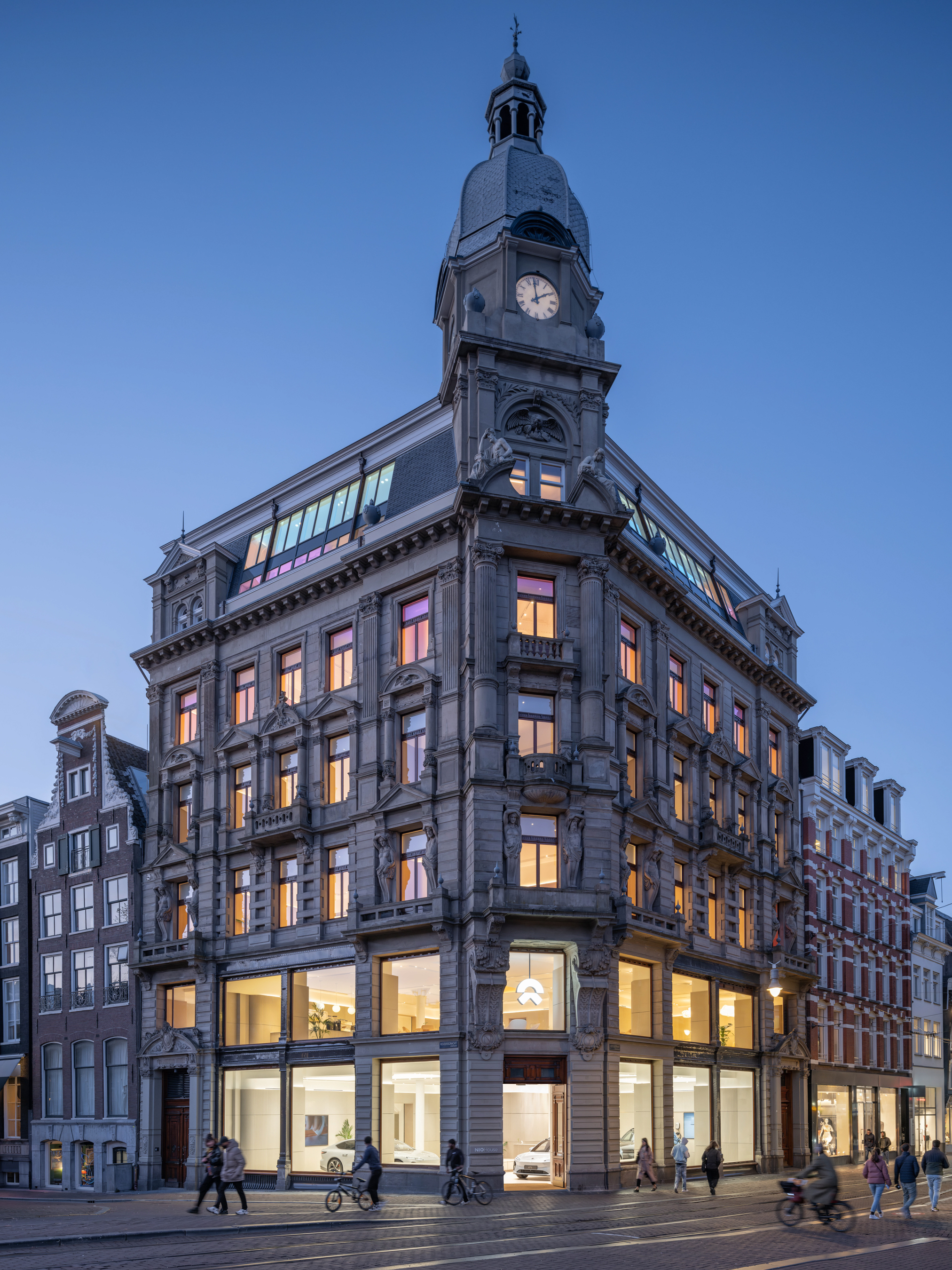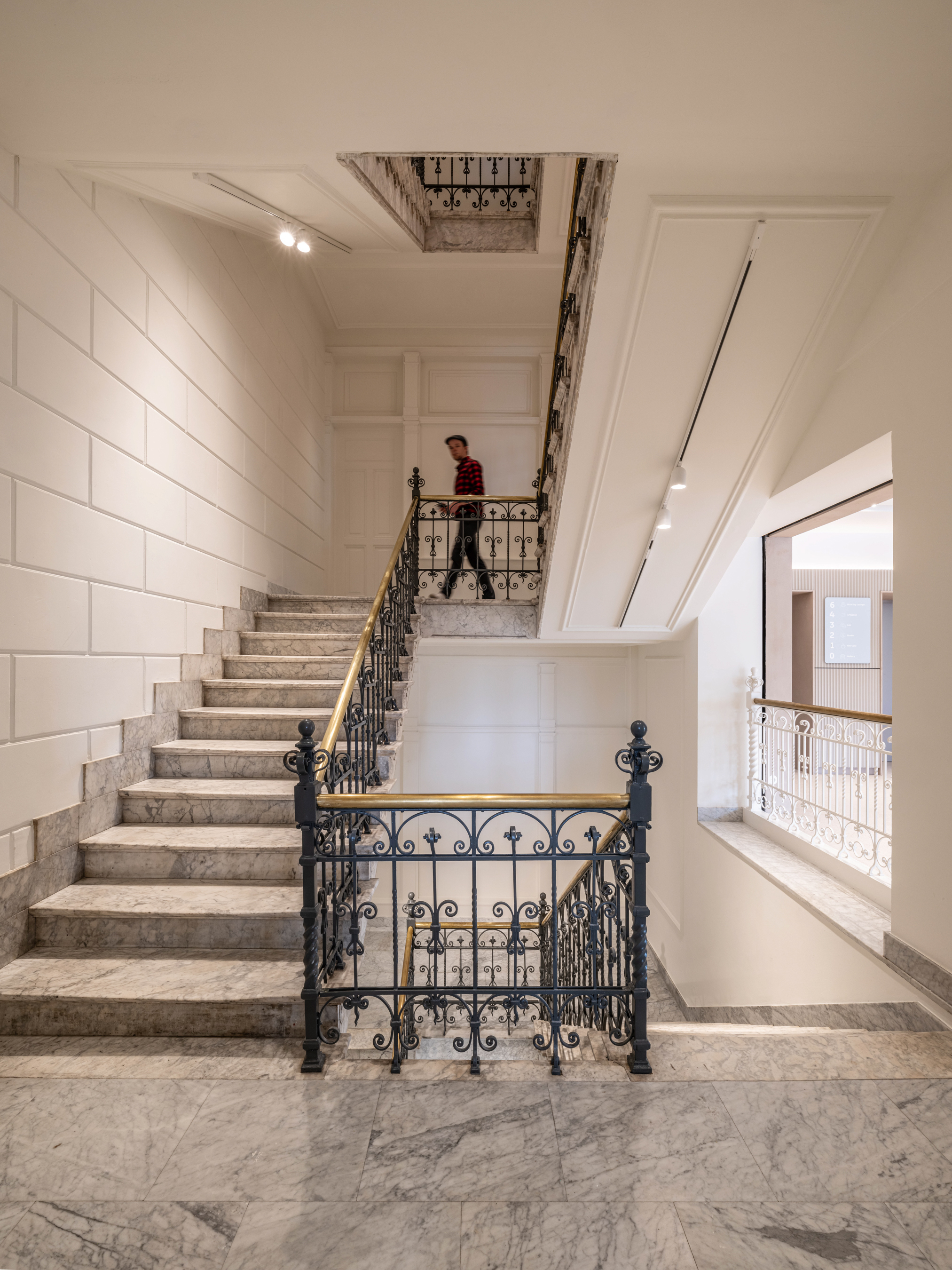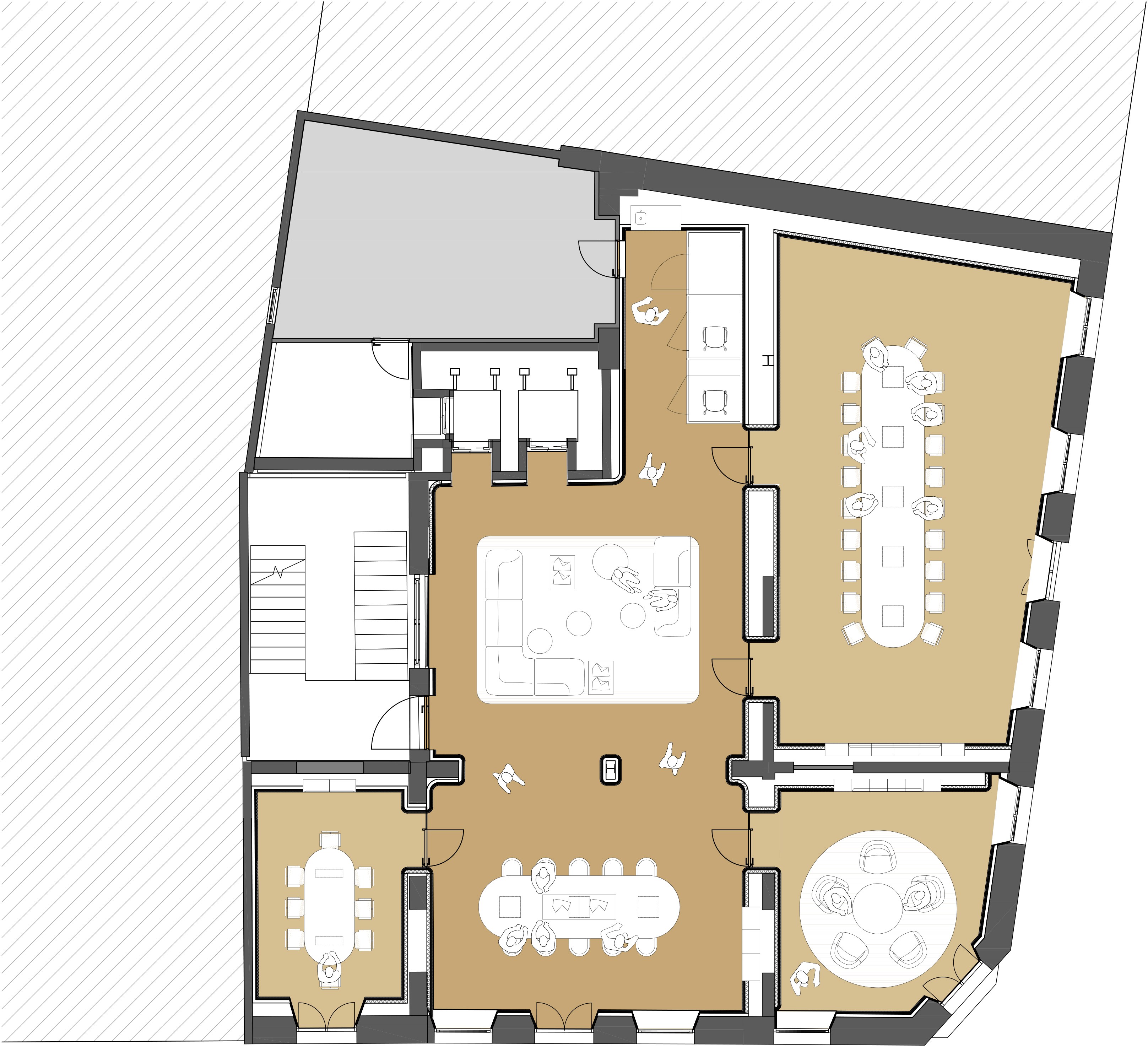由MVRDV为智能电动汽车品牌蔚来设计的欧洲最大“蔚来中心”现已正式开幕。整栋“蔚来中心”共有七层楼高,由一座百年历史的保护建筑改造而来,位于阿姆斯特丹主运河之一Keizersgracht的河畔。基于对蔚来品牌文化的理解和对历史建筑的尊重,MVRDV对建筑和室内进行改造,营造能够满足休闲、办公、活动和展览的复合功能空间。受到品牌“蔚来已来”的愿景,MVRDV设计了随着楼层渐变的空间色谱,从较低楼层的大地色系,到现代主义风格的天蓝色屋顶展厅。
Electric car manufacturer NIO has opened its flagship location in Europe, occupying a seven-storey building on Amsterdam’s Keizersgracht originally built in the late 19th century. The new NIO House Amsterdam renovates the building with an interior design by MVRDV, which combines design elements reflective of NIO’s brand with a respectful treatment of the historic building. Now offering a wide variety of spaces for relaxing, working, events, and exhibitions, the building’s floors form a colour gradient inspired by NIO’s “blue sky coming” slogan, from earthy colours on the lower floors to an airy blue that fills the building’s modernist rooftop pavilion.

建筑本身记载着传奇般的历史:始建于1891年,由建筑师Jan van Looy为纽约人寿保险公司设计,是当时阿姆斯特丹最高的私有建筑之一;20世纪的大部分时间里,这里都是Metz & Co百货公司的所在地,后于1933年的扩建中,增加了由建筑师Gerrit Rietveld设计的钢结构玻璃屋顶展厅(Gerrit Rietveld是荷兰现代主义运动最重要的代表建筑师);2013年,Abercrombie & Fitch入驻后,建筑内高楼层的空间关闭,包括Rietveld设计的屋顶展厅,室内许多原有的细节也被掩盖。
The building has a storied history: designed by Jan van Looy, when it was built in 1891 for the New York Life Insurance company it was among the tallest private buildings in Amsterdam. For the majority of the 20th century, it was home to the Metz & Co department store and in 1933 was extended by a steel and glass rooftop pavilion designed by Gerrit Rietveld, arguably the most important Dutch architect of the modernist movement. Despite this heritage, in 2013 it became home to an Abercrombie & Fitch store; as a consequence, the upper floors including the Rietveld pavilion were closed to the public, and many of the original interior details were covered up.


如同在世界其他的城市中一样,蔚来中心不仅将建筑本身转换为一个典型的汽车陈列空间,也为空间赋予了更强的功能性和公共性,与所在的社区产生积极互动。一楼是汽车展厅,展厅上方设置了咖啡厅,包含一个暖黄色的儿童空间;二楼是论坛空间,用于各种研讨会、分享会和小型讲座,相邻区域还设置了一个“乐营”儿童游乐区。三楼配置了可供公众预订使用的联合办公空间,四楼包含了一间艺术和设计画廊,用于陈列蔚来的产品,也可作为当地艺术家展示作品的平台。五层是蔚来的办公空间,六层是活动空间,顶层则是一间展厅。
Just as in all of their locations worldwide, the arrival of a NIO House turns the building not just into a typical “car showroom”, but a public building with a variety of functions that contribute to the neighbourhood that hosts it. Above the car showcase on the ground floor is a café including a soft yellow kids’ corner; next, the second floor is home to the Forum, which local businesses and event organisations can utilise for workshops, presentations, and small-scale lectures, alongside a “Joy Camp” where children can entertain themselves. The third floor features co-working spaces that can be booked and used by the public, while the fourth is home to an art and design gallery that can equally be used to show NIO products or as a platform for local artists to showcase their work. Finally – above a fifth floor reserved for NIO’s own offices – are event spaces in the sixth floor and the rooftop pavilion.




设计团队在改造中保留并展示了室内楼梯的历史细节,使其成为空间的核心元素,贯穿每个楼层。通过拆除内墙、抬高天花板,整体空间被最大程度地打开,创造出明亮通透的环境;同时强调了空间的纵向联系,例如贯穿了地面层展厅和上层咖啡馆的中庭。
In MVRDV’s design the staircase, with its historic details once again revealed, becomes a central element of the design, and is always visible from the main spaces on each floor to help orient visitors. Throughout the project, the space is opened as much as possible to create a light and airy environment, removing internal walls, raising ceilings, and emphasising vertical connections such as the atrium that links the ground floor with the café.

MVRDV创始合伙人Jacob van Rijs表示:“阿姆斯特丹蔚来中心项目最令人兴奋的挑战在于,如何将这座百年建筑的历史与蔚来的品牌形象统一起来,展示品牌对未来的愿景。从某种意义上说,这与Rietveld在九十年前用优雅方式解决的挑战类似。这次,我们探索了新与旧之间的奇妙对话,以及是这两者是如何从对立最终走向融合的。”
“The exciting challenge of this project was in unifying the history of this building with the identity of NIO, a company which in many senses is interested in offering a vision of the future”, says MVRDV founding partner Jacob van Rijs. “In a sense, we are confronting the same challenge that Rietveld resolved so gracefully 90 years ago. NIO House Amsterdam shows how the old and the new can provide a counterpoint for one another and ultimately enrich each other.”


设计团队为阿姆斯特丹蔚来中心设置了一套材料色谱。随着楼层上升,材料的效果逐渐向更加纯净和轻盈过渡,隐喻从地球到天空的氛围变化。地面的两层空间墙壁安装了由回收饮料纸盒 3D打印而成的饰面材料,由MVRDV与荷兰3D材料打印公司Aectual合作开发,为墙壁赋予质朴的颜色和具有质感的纹理。同时,地板采用了天然铺地品牌Duracryl的Durabella系列,这是一种由可再生资源制成的可持续水磨石地板。顶部楼层空间的墙壁和地板均采用木材,三楼的木地板采用环保油漆。四楼的墙壁采用了桃红色向橙色的渐变,将视线引导至从原建筑保留下来的拱形天花板。
The design team devised a palette of materials that becomes progressively cleaner and lighter as it ascends the building, suggesting an atmospheric journey from earth to sky. On the ground and first floors, the walls are panelled with a 3D-printed material made from recycled drinks cartons, developed in partnership with Amsterdam-based Aectual, which gives an earthy colour and a fluted texture to the walls. Meanwhile the floors are made from Duracryl’s Durabella, a sustainable terrazzo flooring made with renewable resources. On the level above, the walls and floors are finished with wood, while on the third floor, wood floors are complemented with eco-friendly paint. The fourth floor features a peachy orange gradient on its walls, which draw attention upwards to the vaulted ceilings of the original building.



垂直的渐变在最高处的两层空间达到顶峰。第六层空间的墙壁从金色过渡到蓝色,通向Rietveld展厅的天蓝色空间。在这里,这段现代主义历史的精髓得到了尊重和传承,精致的软装也为举办晚会和秀场等活动提供优雅的场所,就像这里百年前经历的场景一样。延续了Rietveld设计的玻璃外墙,人们可以在开敞明亮的顶层欣赏阿姆斯特丹市中心的优美天际线,感受“未来已来”的独特体验。
This gradual vertical change culminates in the top two floors. The walls of the sixth transition from gold to blue, leading into the sky-blue floor, finishes, and ceiling of the Rietveld pavilion. Here, the essence of this piece of modernist history is faithfully preserved, with refined finishes such as the carpet and curtains helping to make it an exquisite space for events such as galas and fashion shows – just as it was almost 100 years ago. The glass walls of Rietveld’s design give panoramic views over the rooftops of Amsterdam, completing the feeling of expansive lightness and giving space for visitors to reflect on the future to come.




设计图纸 ▽







上一篇:入围方案|河套深港科技创新合作区,国际协同创新区北区(二标段) / 施耐德舒马赫
下一篇:中标方案——光明国际马术中心|汤桦建筑设计+深圳机械院